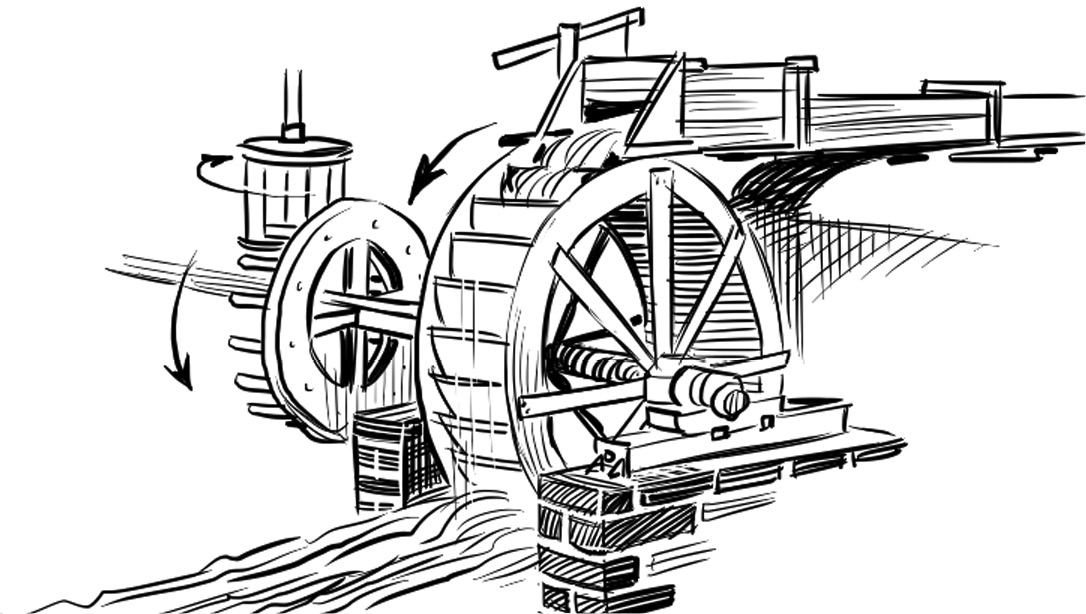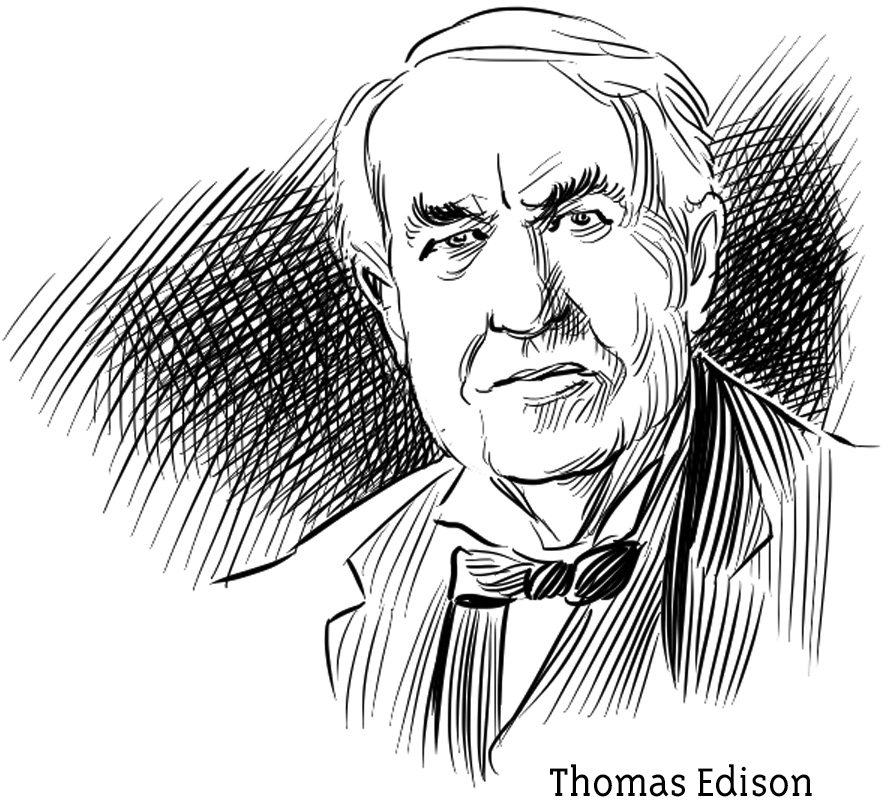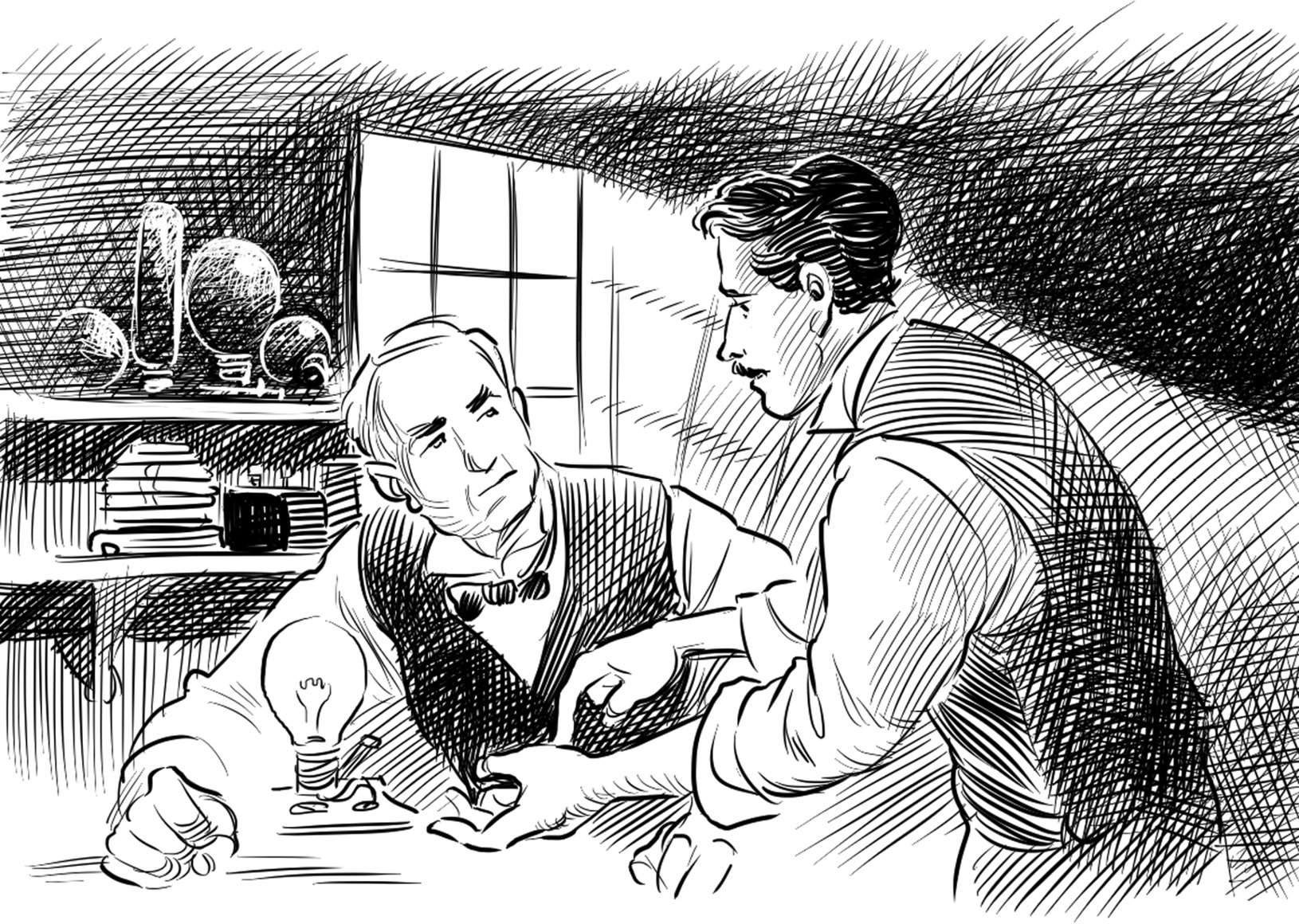CHAPTER 7
Turning Water into Electricity
The force of Niagara Falls is more powerful than you can imagine. As much as 750,000 gallons of water drop over the edge of the falls every second! That much water weighs more than six million pounds! That’s the same as if five hundred grand pianos, one thousand refrigerators, and nine hundred trucks all landed at once—and then the same number kept coming every second after that!
All that water has a lot of power in it. In fact, when Augustus Porter built the first water mill at Niagara Falls, he knew he could use only a tiny little bit of the waterfall. He built a small canal to direct some of the Niagara River off to the side. From there, the water in the canal turned a waterwheel. If Porter had tried to put a waterwheel under Niagara Falls itself, the weight of the water would have smashed the wheel to pieces.


Many people looked at Niagara Falls and wanted to use more of its power. Businessmen thought it was a huge waste to have all that water falling without putting it to work.
The question was: How could they turn Niagara’s water into power?

The first to succeed was Jacob Schoellkopf. In 1877, he bought Augustus Porter’s canal. Then he ran several waterwheels at once, using the power of the falls. Each one sent power to a different business. A few years later, he used the water to run a small generator that lit up sixteen streetlights in Niagara Falls, New York.

Very few people had electric lights in those days. Thomas Edison had invented the first practical lightbulb in 1879. But at that time, there was no good way to get electricity into people’s homes.

Why not? The electricity that Edison used was called “direct current.” Current is the word that refers to electricity running through wires. In those days, direct current could travel only a short distance—a few miles. For electric lights, there would have to be a better way to get electricity to homes. Electricity would have to travel for hundreds of miles—especially if the power of Niagara Falls was going to be put to work.
The Niagara Falls Power Company asked Thomas Edison to help them solve the problem. At first, Edison tried to help. But Edison was stubborn. He refused to think about anything other than direct current. His plans were too expensive.

Meanwhile, a young man in Europe had come up with a different idea. His name was Nikola Tesla.
Tesla was a genius. When he was four, he invented a waterwheel that would spin smoothly in water—without any paddles! He was so smart, he could memorize a page of facts just by looking at it once. As a teenager, he came up with some ideas about a new kind of electricity called “alternating current.” Alternating current is the kind of electricity we use today. It can travel many miles from the place where it’s created.
When he was twenty-eight years old, Nikola Tesla sailed to America and went to work for Thomas Edison. Tesla tried to convince Edison to use alternating current. But Edison wouldn’t listen. He told Tesla, “Spare me that nonsense. It’s dangerous. We’re set up for direct current in America. People like it, and it’s all I’ll ever fool with.”

Then Edison cheated Tesla out of some money he had promised to pay him!
So Tesla quit his job. He went to see another inventor named George Westinghouse. Westinghouse was a rival of Edison’s. He liked the idea of alternating current. He paid Tesla a lot of money for his ideas. And he promised to pay Tesla $2.50 for every horsepower created. Horsepower is a term that defines the way electricity is measured. With this deal, Tesla was going to be rich!


Now the Niagara Falls Power Company knew they had a good way to send electricity to cities many miles away. So they dug a huge tunnel, more than a mile long, under the town of Niagara Falls. The tunnel gave them a way to change the path of some of the water. By shifting the water away from the falls, they could control the amount of water going over the falls, and use the rest for power. Tesla said it would create enough power to light every lamp in America!
It took a few years to finish building the power plant. When it was done in 1896, Tesla and Westinghouse came to Niagara Falls for a big ceremony. It was time to flip a switch and see if it worked. Would the electricity travel all the way to Buffalo, New York? Would Niagara Falls become famous for helping to light up the world?
The mayor of Buffalo wasn’t sure, so he waited until midnight to flip the switch. If it didn’t work, he didn’t want people to know!
But the lights came on, and Tesla was a hero. Niagara Falls was famous! It was the first time electricity had been sent a long distance. Now people all over America could have electricity in their homes.
Tesla was rich, but he was generous, too. A year later, George Westinghouse came to ask Tesla a favor. The Westinghouse Company was going broke because they owed Tesla so much money. They had created so much horsepower, they owed him $12 million! Tesla agreed to give up his $2.50 payment for each horsepower in order to keep the Westinghouse Company from going bankrupt.
Today, the Westinghouse Company has become General Electric, or GE. And today, there is an electric car named for Nikola Tesla.

There is also a newer, modern power plant at Niagara Falls now. But it works pretty much the same way the old one did. Water from the Niagara River is diverted—forced to go off to the side—at the push of a button. It is sent through long, underground tunnels to the power plant. This means that people running the power plant can turn the water “down” on Niagara Falls. Or they can turn it up!


The United States and Canada have agreed that they’ll never turn the falls down too much, though. They signed a treaty—an agreement. It says that at least half the water from the river should be allowed to flow over the falls during the day, in tourist season. That way, people can enjoy the beautiful sight. At night, when people are sleeping, more of the water is used for electricity.
Since the water is always being turned down some, no one today sees Niagara Falls the way it used to look, hundreds of years ago. It’s only half as amazing as it used to be.
